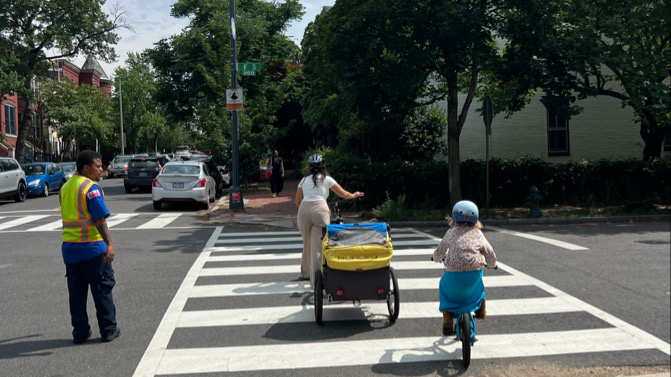In my first blog in the Safe Routes to School (SRTS) series, I introduced the framework and its six pillars—Evaluation, Engineering, Enforcement, Education, Encouragement, and Equity—that work together to create safer pathways for students traveling to and from school. These interconnected strategies help communities address the barriers that prevent children from walking, biking, or using other active transportation options.
In this follow-up article, the second blog in the series, we’re diving deeper into the first three pillars: Evaluation, Engineering, and Enforcement. These pillars focus on assessing existing infrastructure, planning and designing improvements that enhance school zone safety, and collaborating with local authorities to uphold compliance with safety standards. Combined, they form the critical foundation to build safer school routes for the kids in our communities.
What Happens When We Don’t Have SRTS?
It’s 7:45 a.m. on a Tuesday morning at a typical elementary school. Cars are triple-parked along the narrow street, hazard lights blinking in the hazy fall morning as parents rush to drop off their children. Ten-year-old Maya clutches her backpack straps as her mom winds slowly through the congested school zone anxiously searching for a safe place to pull over and drop off her daughter.
Across the street, a crossing guard waves frantically at irritated drivers racing to work who routinely ignore the faded 20 mph school zone sign. There’s no marked crosswalk connecting the neighborhood to the school entrance, forcing students to weave between parked cars and dart across the road during gaps in traffic.
Behind the school, a group of fifth graders arrives by bike but finds nowhere to lock them, since the two rusty bike racks are already overflowing. Meanwhile, parents of students with mobility devices struggle over crumbling sidewalks with missing curb ramps.
This chaotic scene plays out daily at schools across our communities. But it doesn’t have to be this way. Through systematic evaluation of infrastructure gaps, thoughtful engineering of safer designs, and consistent enforcement of traffic laws, communities can convert dangerous school zones into safe, welcoming spaces where every child can arrive ready to learn.
Evaluation, Engineering, & Enforcement
Evaluation, Engineering, and Enforcement are pillars that involve assessing the existing built infrastructure for safety, designing infrastructure to improve school zone safety, and collaborating with local enforcement authorities to uphold compliance with established school zone safety requirements.
Evaluation involves conducting safety audits in the school zone, evaluating the presence and accessibility of sidewalks connecting arrival points to the school, crosswalks, speed humps, curb ramps, school zone signage, bike racks, and more. During this process, it’s important to speak with crossing guards and enforcement officials to gather firsthand accounts of the safety challenges students and their families face daily. From there, planners and engineers develop recommendations that improve school zone safety. It is important to make sure that recommended solutions are context sensitive.
Once recommendations are developed, planners and engineers present their findings to school administration, elected officials, local enforcement authorities, and community stakeholders. This public engagement process serves not only to gather feedback but also to build awareness and foster community buy-in. Increased awareness of school zone safety can support the successful enforcement of newly adopted regulations.
Collaboration with local law enforcement is essential to uphold these regulations—such as speed limits, parking restrictions, and crosswalk compliance—and to reinforce a culture of safety around schools. By combining thoughtful evaluation, responsive engineering, and consistent enforcement, communities can create safer, more welcoming environments for students to walk and bike to school.
Creating Safer School Zones Across All Communities
School zone safety recommendations are typically divided into two categories: operational improvements and infrastructure improvements. Operational recommendations assist with managing circulation within school zones, especially during morning and afternoon bell times.
Operational Recommendations
- Drop-Off/Pick-Up Protocols: Planned improvements can allow quick or extensive installation. Quick-build improvements include identifying curb space, modifying on-street parking restrictions, and providing appropriate signage in these areas.
- Crossing Guard Coverage: Establishing crossing guard coverage to assist students who walk, bike, or use transit to safely cross hazardous intersections within the school zone.
- Walking School Buses: Encourage and organize supervised walking groups from designated parking areas to promote safety and social connection, while reducing congestion near school entrances.
- Staggered Dismissal: Stagger dismissal by grade to manage the flow of students and guardians picking up.
Due to differing built needs, infrastructure recommendations are separated into rural, suburban, and urban contexts.
Infrastructure Recommendations in Rural Communities
Rural areas often face unique challenges such as long travel distances, high-speed roads, and lack of sidewalks. SRTS strategies here focus on basic infrastructure and school community engagement.
Key recommendations include:
- Shared Use Paths: Though rural communities may not build sidewalks on every road, scenic shared-use paths can serve as important points of connection between neighborhoods and schools.
- Sidewalk Installation: Where sidewalks are feasible, prioritize building them along key corridors, especially between clustered schools or community centers.
- Traffic Calming on High-Speed Roads: On these key corridors, consider installing speed tables, signage, and daylighting to slow traffic on rural arterial and collector roads.
- Community-Led Engagement and Education: Leverage local knowledge through parent and caregiver surveys, community pop-up events, and school-specific focus groups. Another important avenue is integrating safety education into physical education classes. Programs such as traffic gardens and biking clinics can equip children with essential safety habits from an early age.
- Funding Support: Provide technical assistance to help rural schools apply for federal SRTS grants.
Infrastructure Recommendations in Suburban Communities
Suburban schools often have sprawling campuses, moderate traffic, and mixed land uses. These features present a unique opportunity for recommendations to focus on connectivity, education, and scalable design.
Key recommendations include:
- Community Mapping Tools: Use interactive StoryMaps and online platforms to gather feedback and identify barriers to walking and biking. Use results to target improvements.
- Standardized Design Guidelines: Implement adaptable templates for school signage, crosswalks, and traffic calming measures that can be scaled across multiple campuses. Consistent design helps drivers more easily recognize school zones, prompting safer driving behavior and increased awareness of pedestrians and bicyclists.
- Intersection Improvements: Target key corridors with moderate traffic for infrastructure upgrades like pedestrian signals, accessible curb ramps, speed humps, and daylighting intersections.
- Park & Walk Programs: Encourage families to park a few blocks away and walk with their children, helping to reduce traffic congestion near school entrances. These efforts can be amplified through organized Walk and Bike to School Day events, where families participate alongside school staff to promote active transportation and community engagement.
- Educational Campaigns: Deploy age-appropriate materials like coloring books, posters, and interactive maps to teach safety behaviors. These activities can also teach children what traffic signs mean and what to do when they see those signs.
Infrastructure Recommendations in Urban Communities
Urban schools are often surrounded by dense traffic, complex intersections, and limited space. SRTS strategies here emphasize pedestrian and bicyclist visibility, quick-build infrastructure, and enforcement.
Key recommendations include:
- Daylighting and Flex Posts: Improve visibility at intersections, crosswalks, and drop-off zones by installing vertical delineators and curb extensions. Curb extensions—also known as bulb-outs—are traffic-calming features that extend the sidewalk or curb line into the street, typically at intersections or mid-block crossings. Their purpose is to shorten pedestrian crossing distances, improve visibility, and encourage drivers to slow down.
- Speed Limit Signage and Enforcement: Install flashing school zone signs and coordinate with local agencies for speed camera enforcement.
- Crosswalk Enhancements: Use high-visibility markings, raised crosswalks, and pedestrian refuge islands where feasible to improve safety around crosswalks.
- Parent Drop-Off Management and Aftercare Safety Coverage: Redesign circulation patterns and signage to reduce congestion and improve safety during drop-off and pick-up hours. Address gaps in crossing guard coverage during late pick-up times through surveys and staffing coordination.
It is important to note that when planning, designing, and building school zone infrastructure, we incorporate and adhere to the Americans with Disabilities Act as well as Manual on Uniform Traffic Control Devices (MUTCD) guidelines.
Creating safer school routes ensures every child in any community can travel to and from school without worry, regardless of how they get there. When we invest in thoughtful evaluation, smart engineering, and consistent enforcement, we invest in our children’s safety, health, and future.
Coming Next: Education, Encouragement, and Equity
While Evaluation, Engineering, and Enforcement create the physical foundation for safer school zones, the journey doesn’t end there. In my third and final blog in this series, I’ll explore Education, Encouragement, and Equity. These pillars empower students and families with knowledge, inspire behavioral change, and ensure safe routes to school are accessible to all children, regardless of their neighborhood or circumstances.
Stay tuned to discover how these elements work together to build a comprehensive SRTS program that can upgrade school travel from a daily risk into a positive community experience.


